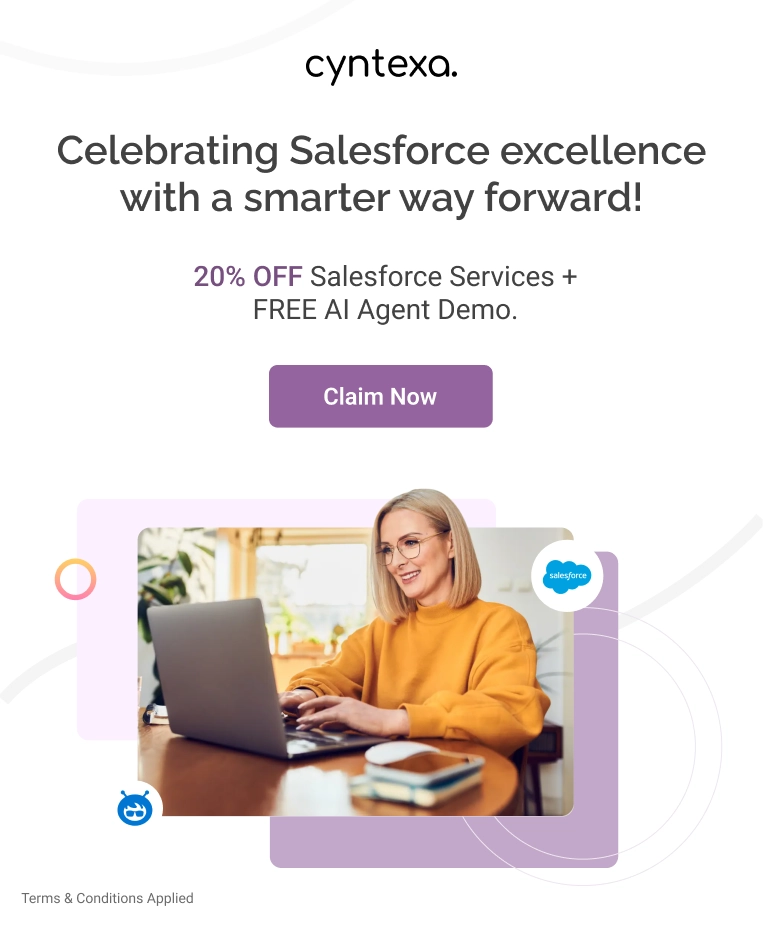Headless Commerce: Definition, Architecture, and Benefits for Your Business
Table of Contents
The rules of digital commerce have changed. Today’s buyers expect lightning-fast websites, personalized journeys, and seamless experiences across every device and channel. But for many B2B businesses, outdated, monolithic platforms are slowing them down.
This is where headless commerce provides a strong solution with its flexible approach that gives you full control over the customer experience while maintaining the stability of your backend systems. It’s not just a tech upgrade; it’s a growth strategy built for scale, speed, and future-ready innovation.
Ready to explore how it can transform your business with headless commerce solutions? Let’s get started!
What is Headless Commerce?
Headless commerce is the decoupling of an e-commerce application’s front end from the back end. The separation of an e-commerce application’s front end (your storefront and user experience) from the back end (your data) gives freedom to get creative and customize how customers interact with it, without being held back by any tech limitations in the backend. This architecture allows the front and back ends to operate independently, meaning changes on one end do not affect the other.
Headless commerce allows businesses to build their front end using various technologies such as React.js, Angular, Vue.js, or Next.js, enhancing the overall customer experience. Meanwhile, they can utilize specialized e-commerce platforms, like Salesforce Commerce Cloud, to manage backend tasks such as product management and order fulfillment.
Here are Some of the Real-world Headless Commerce Examples:


- Social Media Shopping:
Integrating e-commerce functionalities directly into social media platforms, allowing customers to shop without leaving the app. This allows customers to browse and purchase products without ever leaving the app, creating a more seamless and engaging buyer journey. - In-Store Kiosks:
Implementing headless commerce to power in-store kiosks that provide a seamless shopping experience by connecting to the same backend as the online store. - B2B Buyer Portals:
These portals provide a personalized experience based on the buyer’s previous orders, pricing agreements, and specific purchasing needs, making the buying process smoother and more efficient.
Headless Commerce Architectural Core Concepts
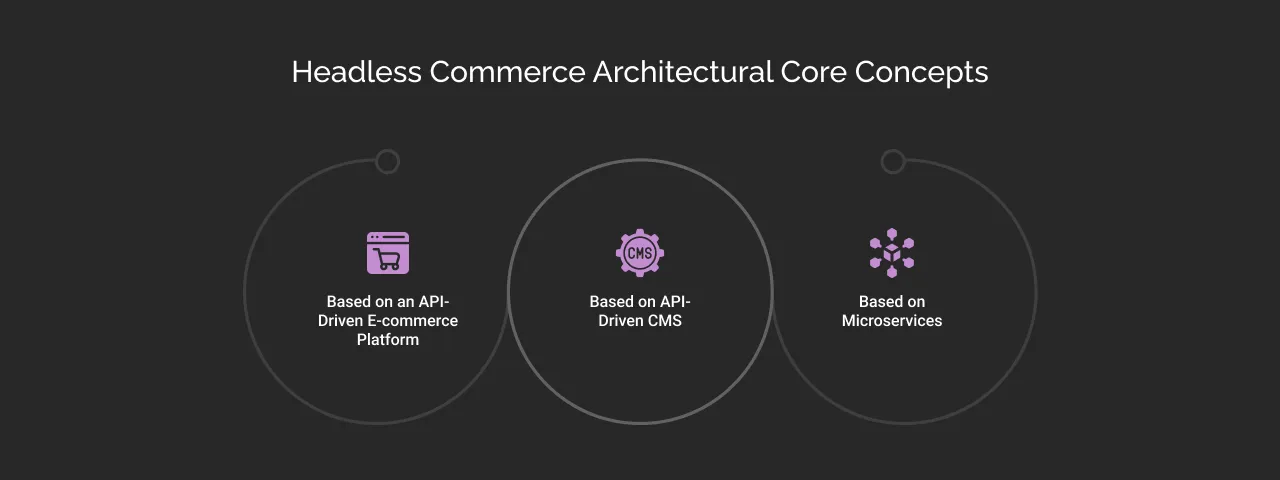
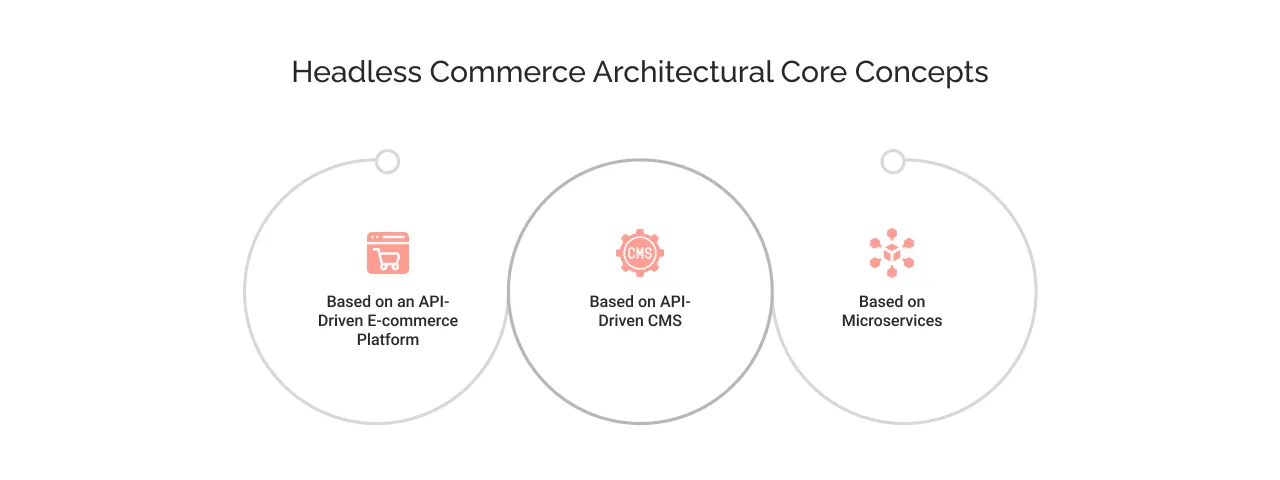
As said above, headless commerce architecture decouples the front-end or presentation from the backend functionality of an ecommerce platform. The architecture is categorized into the following three categories:
1. Based on an API-Driven E-commerce Platform
API-based architecture uses Application Programming Interfaces (APIs) to connect different parts of an e-commerce platform. APIs allow the frontend, backend, content, and product data to communicate with each other, enabling seamless information exchange.
This architecture is beneficial to create a highly customizable user experience tailored to the organization’s specific needs, backed by a robust backend.
API-based headless commerce architecture, your business can leverage the following features:
- Dynamic pricing management that adapts to market conditions.
- Advanced content management capabilities for personalized marketing.
- Comprehensive order management systems that streamline fulfillment.
- Real-time sales performance monitoring for data-driven decision-making.
Flexible product catalog management that supports diverse product types.
2. Based on API-Driven CMS
This architecture works well if you’re building a content-rich website focused on soft-selling marketing or if you already have a CMS-based website and want to add e-commerce features.
This architecture is the key to unlocking these capabilities for your e-commerce business:
- Configurable content templates that can be tailored to meet specific marketing needs.
- Efficient management of digital assets, ensuring that all media is organized and accessible.
- Seamless integration of e-commerce capabilities into existing content workflows, enhancing user engagement.
3. Based on Microservices
This architecture is perfect for planning multiple user journey scenarios and complex business workflows that require sophisticated e-commerce solutions.
The following are the advantages of the microservices architecture:
- Designed with specific business functions in mind, allowing for targeted development.
- Independently developed and deployed, enabling teams to work on different services simultaneously.
- Rapid design, testing, and deployment cycles accelerate time-to-market for new features.
- Interconnected using API calls, ensuring that services can communicate effectively while remaining modular.


Key Distinctions: Traditional vs. Headless vs. Composable
Traditional Approach and Headless Approach
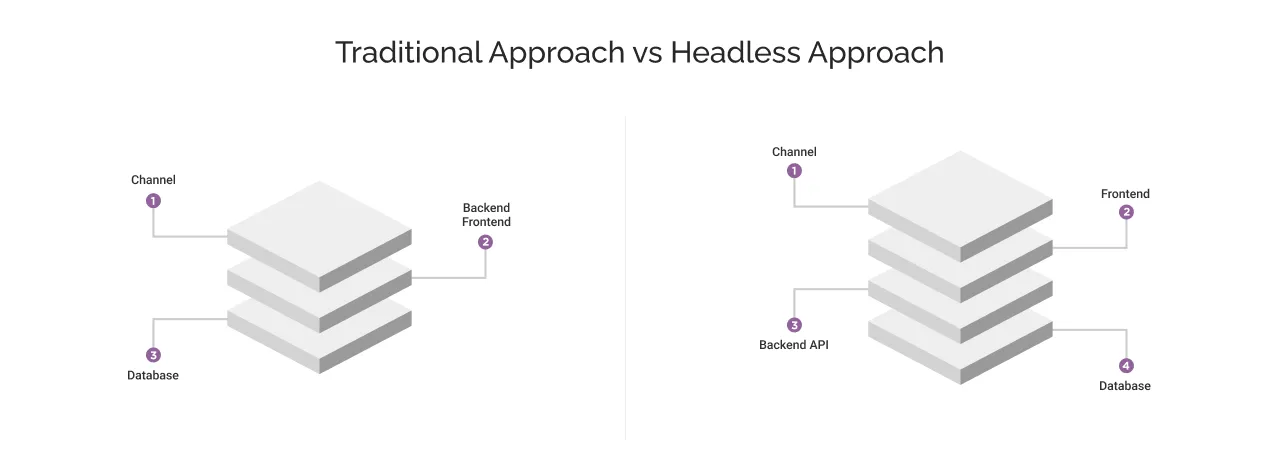
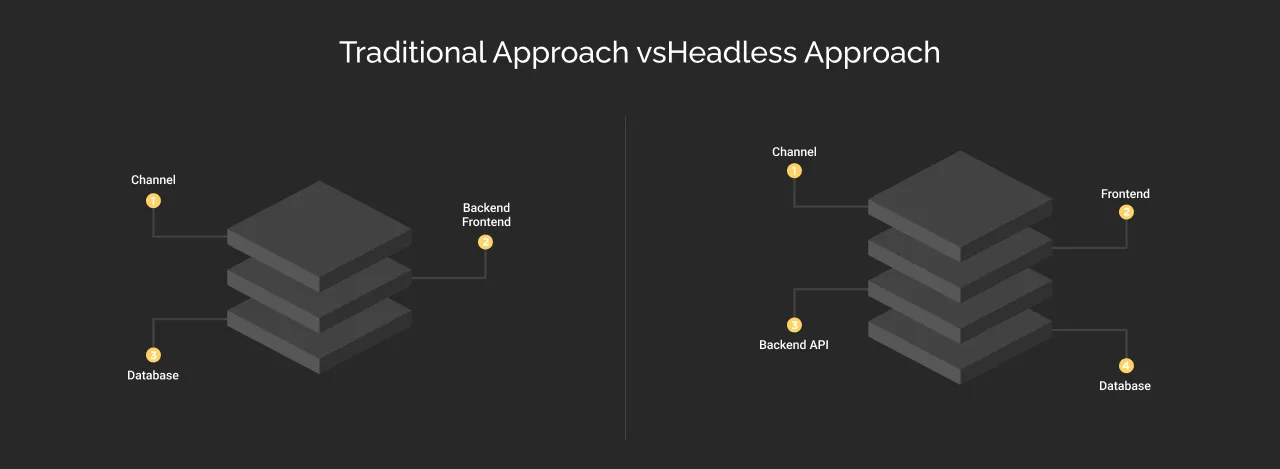
The traditional approach refers to an e-commerce system where the frontend (what users see and interact with) and the backend (the hidden logic, databases, and servers) are tightly integrated into a single, monolithic structure. Think of it like a classic all-in-one desktop computer, where the monitor, CPU, and all internal components are housed within a single, inseparable unit. If you want to upgrade the display, you might have to replace the entire computer, or any small change could potentially affect the whole system, making updates slow and complex.
In contrast, the headless approach allows the backend to operate completely independently from the frontend (the display and user interface). This is much like having a standalone computer tower (the backend) that can connect to any screen you choose. You can easily swap out or update your “display” without needing to touch the core “computer.”
This separation gives you immense flexibility for faster updates, a consistent experience across various devices, and the ability to tailor unique user interfaces without disrupting the underlying system.
Composable Architecture and Headless Commerce
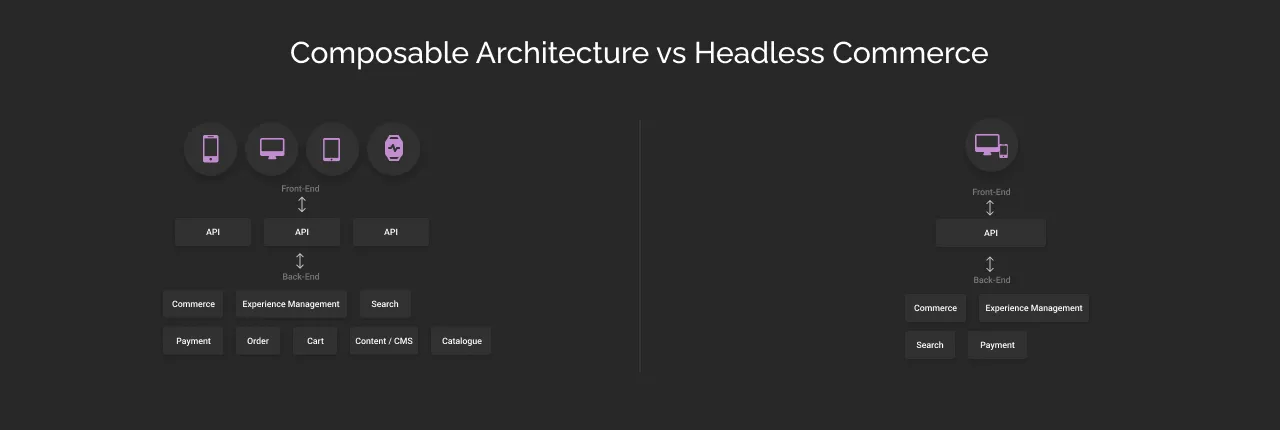
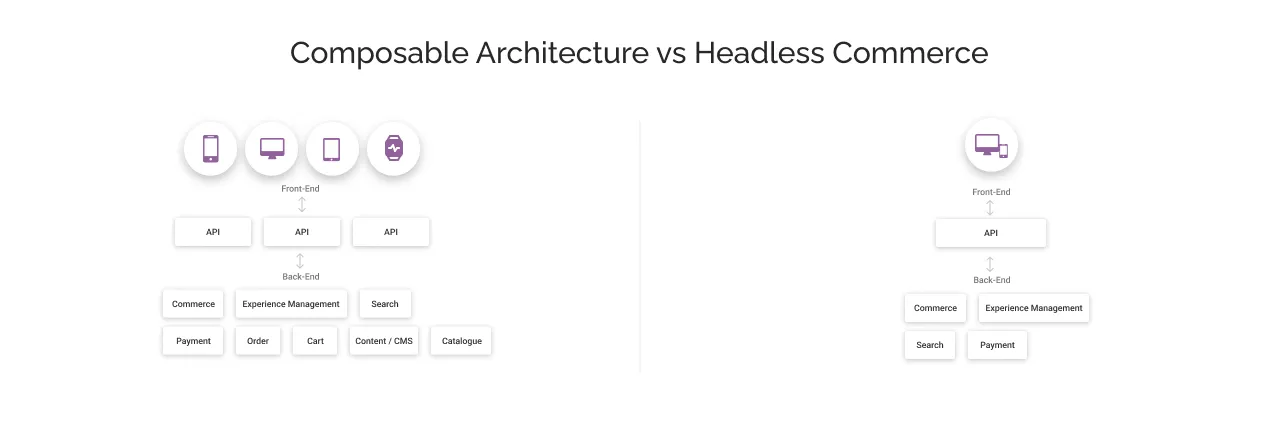
Composable commerce is a term that complements headless commerce in the e-commerce architecture landscape. While headless primarily refers to the decoupling of the frontend and backend of an e-commerce application, composable commerce takes it a step further. It means that every component of the system is independent, allowing businesses to select and integrate each component separately.
How Headless Commerce Works?
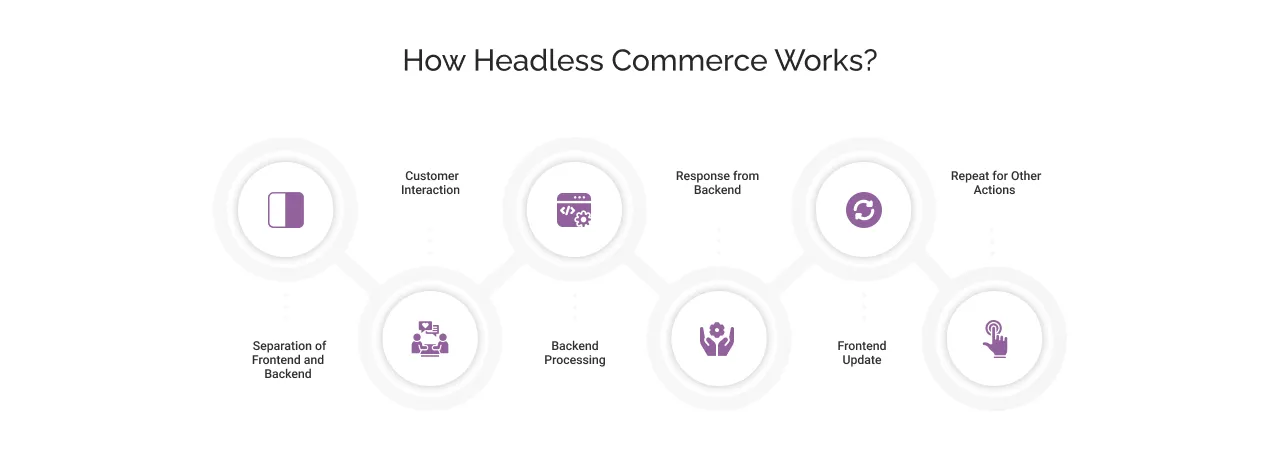
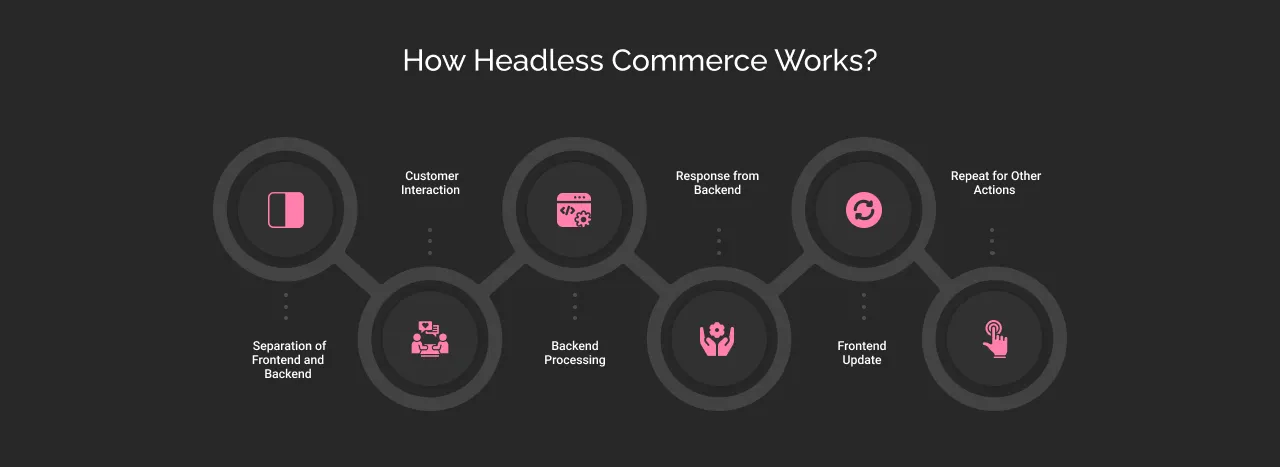
Step 1: Separation of Frontend and Backend
The frontend can be a website, mobile app, or kiosk, and it communicates with the backend through APIs (Application Programming Interfaces).
Step 2: Customer Interaction
When a customer interacts with the frontend, such as clicking “Add to Cart” or “Add to Wishlist,” the frontend sends a request to the backend.
Step 3: Backend Processing
The backend receives the request and performs necessary actions, such as checking inventory to see if the product is in stock, calculating pricing to determine any discounts, and managing the cart by adding the item.
Step 4: Response from Backend
After processing the request, the backend sends a structured response back to the frontend, confirming the action and providing relevant details like the cart total and items added.
Step 5: Frontend Update
The frontend receives the response and updates the user interface without reloading the page. The customer sees a confirmation message, an updated cart total, and enjoys a faster experience.
Step 6: Repeat for Other Actions
This process is repeated for various actions, such as searching for products, checking out, and managing user accounts.
This approach enhances flexibility and improves the overall customer experience in e-commerce.
How can Headless Commerce be Beneficial?
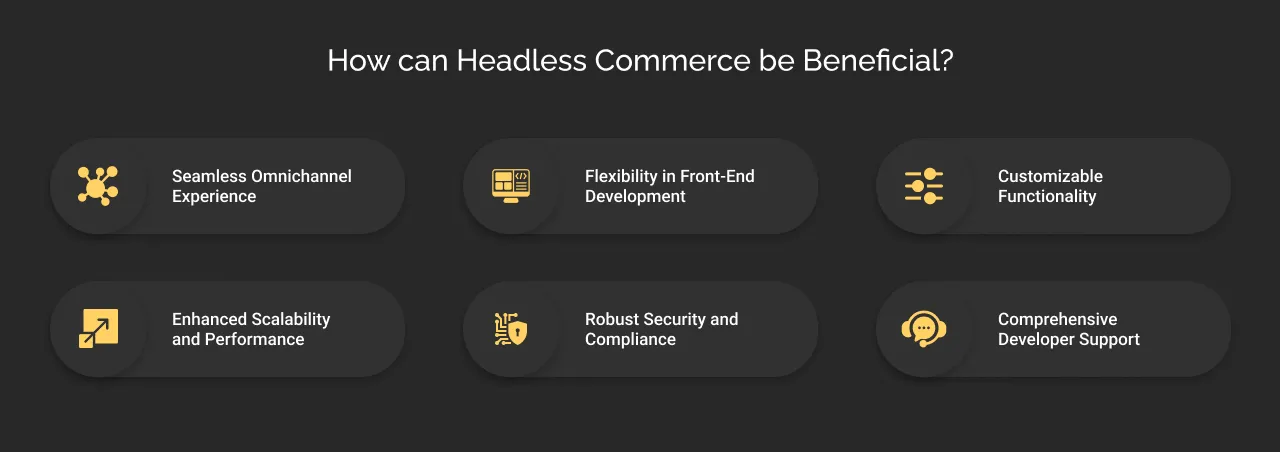
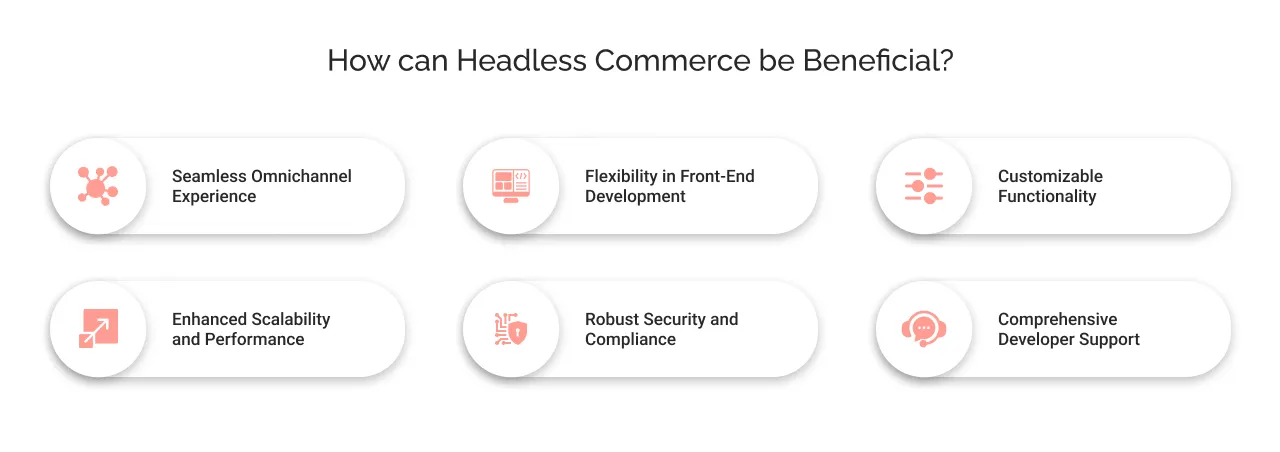
Here are some pointers that validate the benefits of the solution
Seamless Omnichannel Experience
Headless commerce leverages API-powered shopping to connect various touchpoints, enabling businesses to integrate shopping experiences across multiple platforms, including social media, marketplaces, and buyer portals. This ensures a consistent and seamless experience for customers. Further, this also enables multichannel selling for retailers.
Flexibility in Front-End Development
Businesses enjoy the freedom to choose their front-end technology, allowing developers to build custom storefronts using frameworks like React, Angular, or Vue.js. This flexibility ensures a unique brand experience tailored to specific customer needs.
Customizable Functionality
With the ability to create custom API endpoints, businesses can modify functionalities such as pricing, promotions, and inventory management without altering the core back-end system. This adaptability allows for a more personalized shopping experience and faster time to market.
Enhanced Scalability and Performance
Headless commerce platforms are designed to efficiently handle high traffic volumes. Features like API response caching reduce data load and improve response times, ensuring a fast and responsive shopping experience even during peak times.
Robust Security and Compliance
Headless commerce platforms come equipped with advanced security tools, including threat protection and 24/7 monitoring. This reduces the risk of cyber threats and ensures compliance with global data protection regulations, safeguarding customer information.
Comprehensive Developer Support
Salesforce provides a wide range of developer resources, learning tools, and expert guidance to help businesses efficiently build and maintain their headless commerce architecture. This support empowers teams to innovate and optimize their e-commerce solutions effectively.
You can also read here about the benefits of Salesforce Commerce Cloud for eCommerce Businesses.
How to Get Started with Headless Commerce Implementation?
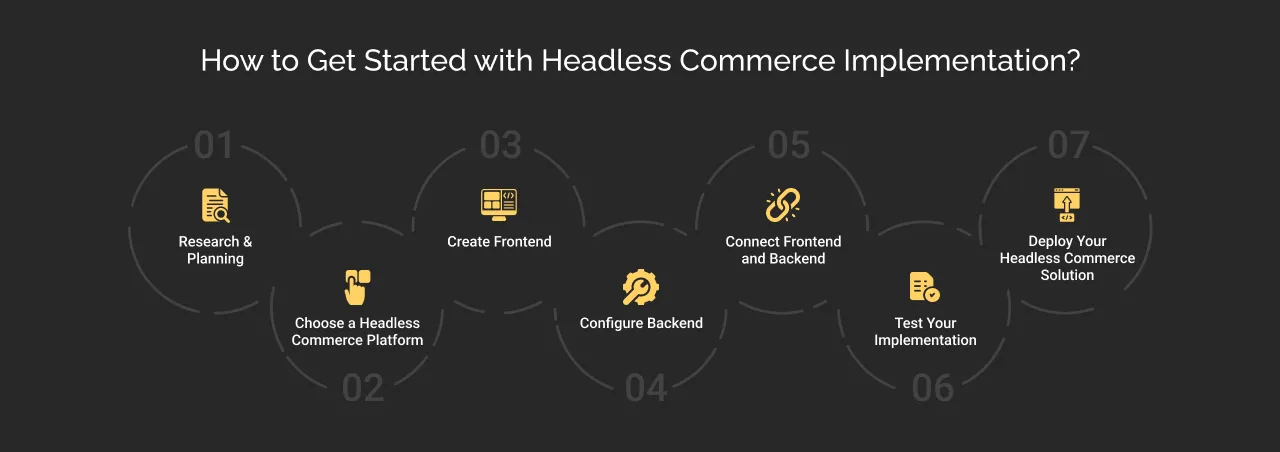
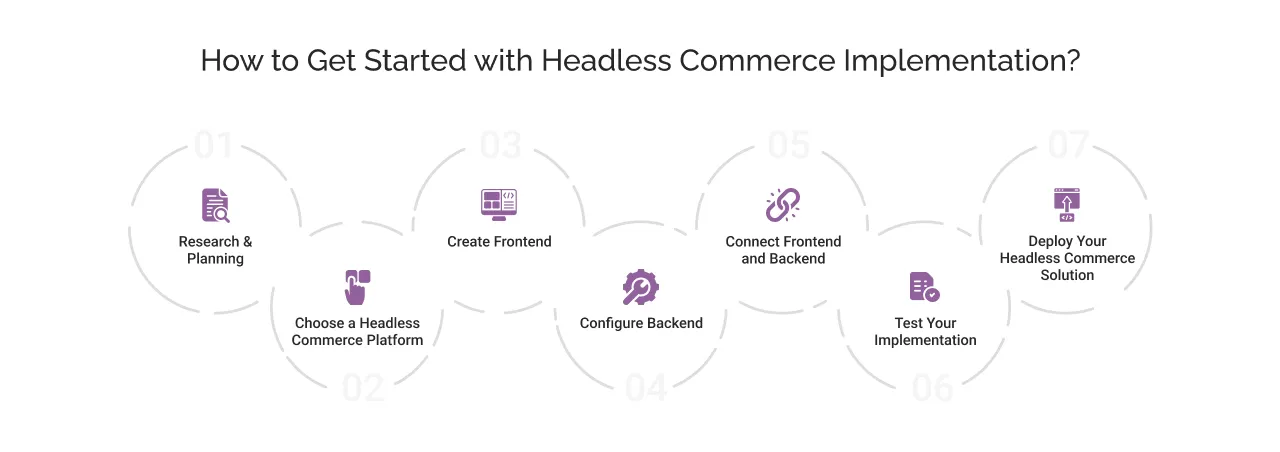
Headless commerce is a rapidly growing trend in the e-commerce industry that enables businesses to create excellent and personalized customer experiences. Here we have shared a step-by-step guide on how to implement headless commerce for your business:
Research & Planning
Research and planning begin by having a profound understanding of your business’s objectives and customer requirements. Once you have identified, the next step is to work on identifying the competitors and market trends to identify the opportunities. Research helps outline the selection of the best third-party services suited to your business. Furthermore, it ensures that the implementation process remains aligned with business needs and addresses potential challenges for successful implementation.
Choose a Headless Commerce Platform
Once you have identified your business requirements, the next step is to choose a headless commerce platform that aligns with those needs.
You can consider these questions before making the final decision:
- Is the platform capable of delivering the customer experience you require?
- Does the platform offer assistance with implementation and resources for delivery?
- What post-launch support and account management do they provide?
There are various headless commerce platforms available, such as:
There are several headless commerce platforms available, each with unique features to meet different business needs:
Salesforce Commerce Cloud: This platform is known for its flexibility and reliability. It offers scalable commerce APIs, tools to enhance developer efficiency, AI-driven personalization, and a progressive web app (PWA) storefront. Additionally, Salesforce provides robust analytics tools to help businesses track customer behavior and optimize user experiences. You can take Salesforce Implementation services to know more about Commerce cloud and its features.
Shopify Plus: As one of the most popular headless commerce platforms, Shopify Plus enables businesses to create engaging and personalized shopping experiences. It comes with extensive documentation and support for developers, making it easier to implement custom solutions tailored to specific needs.
BigCommerce: This platform is built on an API-first philosophy, making it highly capable for headless e-commerce. BigCommerce supports front-end frameworks like Next.js and Gatsby.js, allowing businesses to create their desired user experience. It also facilitates multi-channel selling, enabling businesses to reach customers across various platforms.
Adobe Commerce (formerly Magento): Known for its high level of customization, Adobe Commerce utilizes PWA Studio tools to create a PWA-powered frontend. It integrates seamlessly with Adobe Experience Cloud, enhancing marketing capabilities and providing a comprehensive solution for businesses.
Create Frontend
After establishing your headless commerce platform, the next step is to develop the front end, which should provide a friendly and seamless experience for customers. Implementing design systems can help maintain consistency across your user interface.
Choosing the right front-end framework is crucial for enhancing user experience:
- React: Its component-based architecture allows for reusable UI components, making it easier to maintain a consistent and dynamic interface.
- Vue: Known for its simplicity, it enables quick development of interactive interfaces with reactive data binding, enhancing the fluidity of user interactions through smooth transition effects.
- Angular: This robust framework supports complex applications with features like two-way data binding and built-in routing for better user navigation.
Configure Backend
Configuring the backend of your headless commerce solution involves integrating APIs from your e-commerce platform, setting up databases, servers, and authentication mechanisms. Utilize pre-built APIs, like those from Salesforce Commerce Cloud, for seamless integration with payment and CRM systems. Choose a suitable database (SQL or NoSQL) and optimize it for performance with indexing and caching. Regularly monitor performance to identify bottlenecks and enhance user experience, ensuring your backend can grow with your business.
Connect Frontend and Backend
Once the frontend and backend setups are completed, the next step is to connect the two. You can rely on the APIs provided by the platform to ensure a seamless and secure connection. Document the API endpoints and data flow to facilitate easier troubleshooting and future updates. For example, the Salesforce Commerce Cloud headless API enables businesses to connect their frontend applications with backend systems like product catalogs and payment processing.
Test Your Implementation
Thoroughly test your headless commerce solution to ensure everything works as expected. Include both functional testing and user acceptance testing (UAT) to gather feedback from real users. Testing should cover user experience, data retrieval from the backend, and security measures to protect customer data.
Deploy Your Headless Commerce Solution
Now you’re ready to deploy your headless commerce solution to serve your customers. Plan a phased rollout to monitor performance and address any issues that arise. Keep monitoring the solution’s performance and customer feedback to optimize it for better service.
Best Practices for Implementing a Headless Commerce Platform
Here are some of the best practices that can help in the smooth implementation of the headless commerce platform:
1. Securing Customer Data:
- Adopt end-to-end encryption for data transmission to protect sensitive information.
- Ensure compliance with data privacy regulations such as GDPR and CCPA to safeguard customer rights.
- Conduct regular security audits to identify vulnerabilities in third-party services and mitigate risks.
- Implement multi-factor authentication and access control mechanisms to enhance security.
2. Integrating Third-Party Services:
- Use standardized APIs to ensure compatibility across different architectures and services.
- Maintain regular updates and monitor third-party service performance to ensure reliability.
- Implement scalable integration frameworks to support future growth and adaptability.
- Conduct thorough vendor assessments before onboarding third-party services to ensure quality and security.
3. Customization Cost:
- Leverage pre-built templates and modular components to reduce development time and costs.
- Adopt cloud-based solutions to minimize infrastructure expenses and enhance scalability.
- Implement automated testing to streamline maintenance processes and reduce errors.
- Prioritize cost-effective customization that aligns with business goals and customer needs.
4. Implementing Microservices:
- Define clear business objectives before implementing microservices to ensure alignment with the overall strategy.
- Use containerization technologies like Docker and Kubernetes for efficient deployment and management.
- Ensure cross-functional collaboration between development and business teams to foster innovation.
5. Having a Phased Approach:
The phased approach to launching a headless website allows businesses to modernize their storefront gradually, minimizing risks and costs. Here’s a summary of the key steps:
- Instead of overhauling the entire website at once, businesses should start with the most critical sections, like checkout flows or product display pages.
- A phased rollout helps manage costs and expectations across teams. By implementing changes in stages, businesses can test, learn, and refine their approach before expanding to other areas.
- Each phase should be evaluated based on performance metrics like conversion rates and speed.

Final Take
Headless commerce brings many benefits over traditional commerce. Do you envision adopting headless commerce to create a comprehensive, customized, and unified shopping experience for your customers? Cyntexa is there to move your e-commerce business to headless. Let us know your business goals, and we will assist you in achieving them.
Don’t Worry, We Got You Covered!
Get The Expert curated eGuide straight to your inbox and get going with the Salesforce Excellence.
AUTHOR
Priyanshu
Salesforce Commerce Cloud Expert
Priyanshu, a Commerce Cloud expert, has 6+ years of experience and 8+ certifications. He specializes in crafting seamless, scalable e-commerce solutions that enhance customer experiences, maximize conversions in the digital marketplace. His expertise ensures businesses stay agile, competitive, and customer-centric.


Cyntexa.
Join Our Newsletter. Get Your Daily Dose Of Search Know-How
Frequently Asked Questions
Salesforce enables businesses to go headless by offering scalable Commerce APIs that separate the front end from the back end. Salesforce enables businesses to select the best-fit headless architecture for their businesses that aligns with their business needs and goals
Headless commerce prioritizes the customer experience, which is the key to improving the conversion rate. Businesses have the flexibility to incorporate changes in the frontend to deliver an amazing customer experience.
The best practice to choose a headless implementation partner is to put a strong emphasis on prior experience in building and deploying headless solutions. The partner’s expertise in modern technologies such as APIs, microservices, and serverless architectures can also be used as a selection criterion. The partner’s ability to customize the solution to meet your specific needs can also help you pick the right one for your business.
